Costa Rica is a country that has a lot to offer the vacationer. A colorful variety of animals, insects, large and small plants can be found all over the country. In the highlands it is the quetzal, bird of the gods, that draws attention. The northern border of Costa Rica and Nicaragua is known for the Great Green Macaw which has become a rare sight. Cheeky monkeys frolic in the treetops along with the hard-to-spot sloths and many other residents
The dense jungle, which in some places resembles a mystical fairytale forest, and the dream beaches lined with palm trees are a must see in Costa Rica. The following places, beaches and volcanoes in Costa Rica are intended to give an overview of what there is to discover in the small country and how different a country can be. Be enchanted by the uniqueness of little Costa Rica!
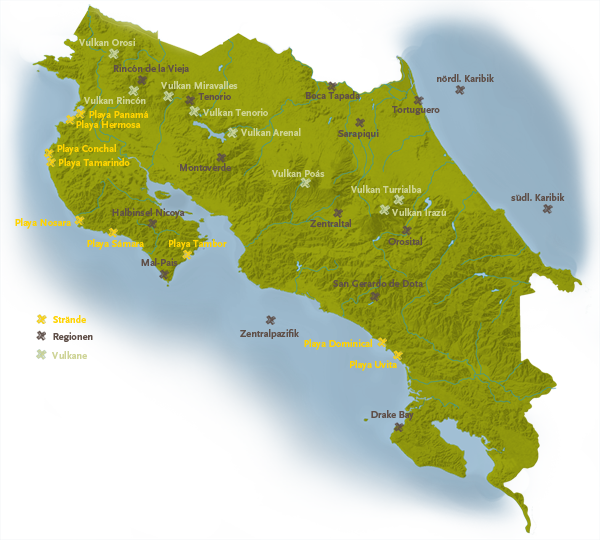
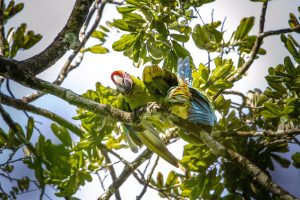 This jungle paradise on the Rio San Carlos is only 12 kilometers from the Nicaragua border. If the border officials of the neighboring state turn a blind eye in their colorful hut then you could even take one of the narrow boats up the border river Rio San Juan which belongs to Nicaragua.
This jungle paradise on the Rio San Carlos is only 12 kilometers from the Nicaragua border. If the border officials of the neighboring state turn a blind eye in their colorful hut then you could even take one of the narrow boats up the border river Rio San Juan which belongs to Nicaragua.
The narrow river boats modernized with outboard engines are still one of the most important means of transportation here and the rivers are the preferred traffic routes. On the rainforest trails, the animals can be observed in their natural habitat. These include the red-eyed tree frog, parrots and caimans. You can get particularly close to the caimans on canoe tours. If you don’t feel like paddling yourself, you can also relax on a boat tour on the Rio San Carlos. There is also an on-site butterfly garden where you can admire many different colored butterflies.
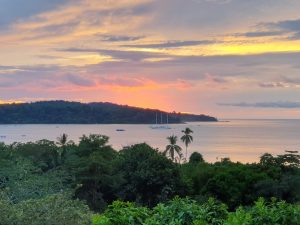 Located in the province of Puntarenas, Drake Bay is named after Sir Francis Drake, an English navigator who anchored here during his circumnavigation of the world in 1597. Like the rest of the Osa Peninsula, Drake Bay is teeming with wildlife including humpback whales , toucans and scarlet macaws.
Located in the province of Puntarenas, Drake Bay is named after Sir Francis Drake, an English navigator who anchored here during his circumnavigation of the world in 1597. Like the rest of the Osa Peninsula, Drake Bay is teeming with wildlife including humpback whales , toucans and scarlet macaws.
From the southern part of Drake Bay you can walk a beautiful path through the jungle. You pass cocoa and coffee fields and then reach the mouth of the Agujitas River, where you can go canoeing through the jungle or simply swim and snorkel .
If you follow this path further, you will reach the beautiful beaches of Playa San Josecito (good for snorkeling) and Rincón de San Josecito. The bays can also be reached by boat from Sierpe. The Sierpe river is considered the largest mangrove area in Central America, and a few specimens of the harpy eagle, an endangered species, are still native here. There is also the possibility to arrive by plane, north of Agujitas there is a small airstrip. During the whale season, end of July to the end of September (sometimes also in January and February), is one of the best places to observe the large mammals. A visit to the nearby Corcovado National Park or a boat trip to Isla del Caño for snorkeling or diving are highly recommended. In Drake Bay there is still a lot of primary forest which reaches many of the beaches. The special feature of many lodges around Drake Bay is that they can only be reached by boat. Here you can relax and enjoy nature.
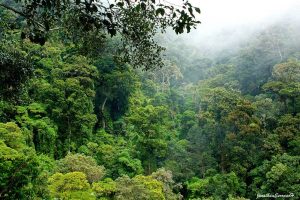
The drive to Monteverde leads over an adventurous gravel road. The mountainous Monteverde (green mountain) is characterized by the tropical mountain cloud forest. The constant high humidity is the reason for the heavy moss and lichen growth, which makes the forest seem like something out of a fairy tale. Even scientists call this ecosystem “the elf forest”. Here you can unwind on long walks and, with a lot of luck, discover the Quetzal bird of paradise.
Monteverde is known worldwide for its cloud forest, but the cheese produced here is also very popular and can be bought almost anywhere in Costa Rica. Production of the cheese began coinciding with the founding of Monteverde in 1951, when several Quaker families moved to the area from the United States. They wanted to make a product that could be stored for a long time. Since Monteverde attracts many travelers due to its fame, there is a sufficient number of accommodations, restaurants, etc.
The huge nature reserve (12,000 hectares) attracts many visitors. Around 2,500 species of plants live here along with over 100 different mammals such as jaguars, pumas , monkeys , tapirs , sloths and more than 120 species of reptiles have been observed. There are more than 400 species of birds, of which the colorful quetzal is probably the most famous. However, if you only aim to observe animals you should not arrive in the rainy season as you will only see very few animals here. It is also advisable to take a local guide with you who can explain when the animals are in which places. The sheer variety of nature in Monteverde alone never gets boring. For those still looking for more adventure, an optional canopy tour is recommended. Fastened to wire ropes, you dart from treetop to treetop and can thus explore the forests from above.
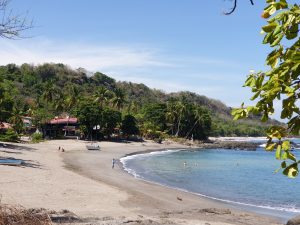
During the ferry crossing from Puntarenas to Paquera you can already feel the vastness of the Nicoya Peninsula which is what catches the eye of the traveler. The offshore islands are mostly uninhabited nature reserves and offer retreats for seabirds and many other animals.
Until shortly before landing, the port is not visible, but surely it is there. A small pub awaits you in Paquera on a road that runs slightly uphill towards Tambor, Montezuma and Malpais. On hot days, the El Timonel restaurant, located about 15 kilometers from Paquera on a pretty river, offers welcome refreshments with numerous fresh fruit juices. The path then continues past the El Curu reserve, from where boat tours to Isla Tortuga are offered in addition to tours in the reserve to the beautiful sandy beach of Tambor. With its sheltered location, the natural bay also offers good swimming conditions for children.
If you follow the road further west, you will see the Hotel Tango Mar on the left, which is perfect for guests who desire a bit more luxury. After another 5 kilometers you reach Montezuma. This small hippie town is perfect for anyone who likes to swim on beautiful beaches, stroll in small shops, and eat in delicious local restaurants and sodas. After another 8 kilometers you are in front of the entrance to the Cabo Blanco National Park . Here you can see different species of monkeys , coatis , bats (during extensive hikes), butterflies and much more. A bumpy road over the hills leads to the beaches of Malpais, Playa Carmen and Santa Teresa. The small street villages here attract surfers who take advantage of the big waves for daring rides. Around 6:00 p.m., after the sun has set on the sea, they come out of the water and fill the small pubs and bars along the streets.
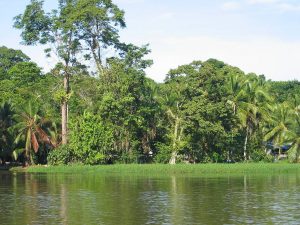
The North Caribbean is characterized by a tangled system of canals and tropical rainforest. Tortuguero National Park is arguably the most famous part of this region. It belongs to a transnational UNESCO biosphere reserve called Indigena Maiz. The remote areas of this region of the Caribbean also offer many opportunities with endless tropical rainforest to explore.
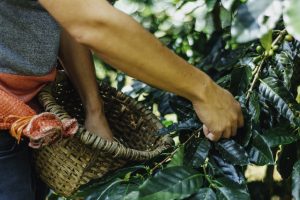 The Orosi Valley is about 1 hour east of the capital San José and offers you everything you could wish for a pleasant and relaxing stay.
The Orosi Valley is about 1 hour east of the capital San José and offers you everything you could wish for a pleasant and relaxing stay.
In this beautiful coffee country you can hike, mountain bike, horseback ride, swim or simply observe the diversity of tropical bird life . There are two thermal baths fed by volcanic springs in close proximity to the Orosi Lodge as well as several refreshing cold pools. In Orosi you will find the oldest church in Costa Rica, which was built in 1743 by the Spanish conquerors. Attached to it there is a small museum for sacred art.
After a walk in the valley, you can continue to Tapanti National Park on the upper reaches of the river. This is one of the rainiest spots in Costa Rica and has a very special flora and fauna because of the height above sea level . You can explore the park on various hiking trails and also discover big cats such as the ocelot and the tiger cat . The Irazú volcano is also not far from Orosí and is definitely worth a visit.
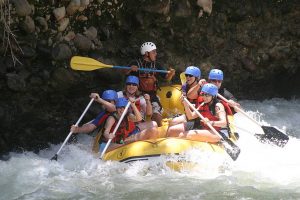
Sarapiquí is located in a rather humid zone and offers impressive vegetation. On the way to Puerto Viejo de Sarapiquí you will see pineapple plantations as well as green pastures and rainforests. The region is ideal for rainforest hikes, boat or rafting tours.
You can go exploring in the tropical rainforest in Sarapiquí. The Tirimbina Biological Reserve is one of the places to go for this. It is a private reserve that is used extensively for research. You can book a chocolate tour on site and have the historical background of this treat explained to you and the individual steps demonstrated. There may even be jaguars in the forest here! Next to the reserve is the Centro Neotropico, which is another great option to learn more about the tropical rainforest ecosystem.
![]()
The volcano Rincón de la Vieja is 1898 meters high in the national park of the same name, about 25 km away from Guanacaste’s provincial capital Liberia in northwestern Costa Rica. At the foot of the Rincón, which is part of the Guanacaste mountain range, you have a choice of three hiking routes of different lengths along which you can see attractions such as sulfur springs and mud pools. There is not only a unique flora and fauna to discover but hikers regularly run into exotic animals such as coatis, iguanas and armadillos.
On various hiking trails you can not only discover the tapir, but also marvel at the volcanic activity. At the Rincón de la Vieja there are several craters, small crater lakes or fumaroles to marvel at. You can sometimes smell the sulfur gasses from afar. There are smaller waterfalls that you can hike up to bathe in wonderfully fresh water. For more information, see the National Park section.
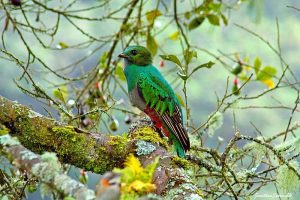
San Gerardo de Dota is located in the highlands of Costa Rica. If you drive from San José via the Panamericana to San Isidro you leave the main road at kilometer 80 and meander in small serpentines into the mountain village. The area is characterized by the mystical cloud forest. It rains here about 360 days a year and from late afternoon visibility becomes relatively poor due to the fog. The rain is mostly just a light drizzle, just enough to get you wet without a raincoat. If you think it’s warm everywhere in Costa Rica, think again (at least at night). Especially in winter it can sometimes get cold down to the freezing point.
When hiking in the adjacent Los Quetzales National Park, you can admire ferns, lianas and of course the jungle giants on various paths. The area is an insider tip for ornithologists, as there is a high probability of seeing the Quetzal, the bird of the gods along with many smaller mammals. For an animal-watching tour it is worth getting up early, preferably around 4:30 a.m., and booking a guide. The forest is busiest early in the morning and in the high and dense thicket it is usually not easy to find animals that are adapted to the forest.
Tip: If you would like to buy a special souvenir, take a look in the small shops of your lodges for the beautiful self-knitted hats. Hardly anyone has a real Costa Rica hat!
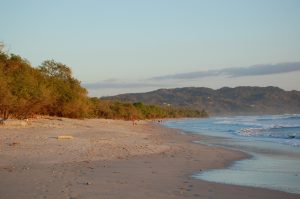
In addition to numerous tropical beaches which are particularly appreciated by surfers due to the high waves, other possible leisure activities here include discovering the various protected areas in the region.
The Cabo Blanco Nature Reserve is the southernmost protected area for the tropical dry forest of Costa Rica. It also includes the island of Cabo Blanco which is home to many birds. Also worth mentioning is the reserve of Guayabo, Negritos and Pájaros, which consists of 4 different islands and to which boat tours are offered. In addition to a diverse animal world where you can spend a lot of time observing, the fine sandy beaches are highly recommended.
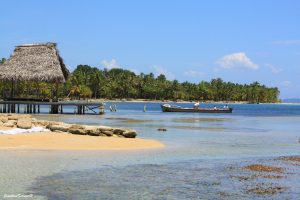
Here you not only get to another geographical region, but you also get to know a completely different mentality of the Costa Ricans. The mentality of the Caribbean people on the coast is very similar to the mentality of the residents of the Greater Antilles, which brings with it the common history. This is where the descendants of the banana workers live, who come mainly from Africa throughout the Caribbean culture. Overall, life is even slower than in the rest of the country! In the remote areas at the foot of the Talamanca Mountains live the last indigenous tribes who have quite an interesting culture and are definitely worth a visit. In addition to a swim in the Caribbean Sea and hikes in the rainforest, there is the opportunity to simply enjoy the time in a balanced relaxed atmosphere and let your soul dangle.
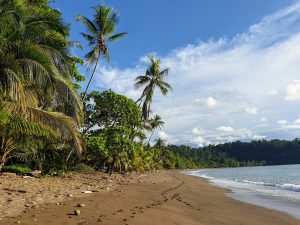 If you are looking for nature in its original form then you will find your own paradise here. The South Pacific region and especially the Osa Peninsula are hardly developed and therefore the ecosystems are hardly affected. Due to the high rainfall you will find beautiful primary forest here which is home to many animals. The beaches of the peninsula are also hardly touched. Between July and September you can spot whales (especially humpback whales) migrating north from the waters of the South Pacific to give birth. Especially in the rainy season, you should be prepared for long journeys and river crossings. But the beauty of this region will make up for it so take your time hiking in the rainforest.
If you are looking for nature in its original form then you will find your own paradise here. The South Pacific region and especially the Osa Peninsula are hardly developed and therefore the ecosystems are hardly affected. Due to the high rainfall you will find beautiful primary forest here which is home to many animals. The beaches of the peninsula are also hardly touched. Between July and September you can spot whales (especially humpback whales) migrating north from the waters of the South Pacific to give birth. Especially in the rainy season, you should be prepared for long journeys and river crossings. But the beauty of this region will make up for it so take your time hiking in the rainforest.
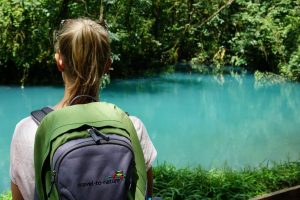
The Río Celeste river is located in the Tenorio National Park. It’s one of those secret spots that hasn’t been discovered by mass tourism yet. This magnificent landscape on the slopes of the Tenorio Volcano offers impressive waterfalls with extraordinary colors due to the minerals washed from the volcano. Here you have the chance to see many wild animals including the Baird’s Tapir (Tapirus bairdii).
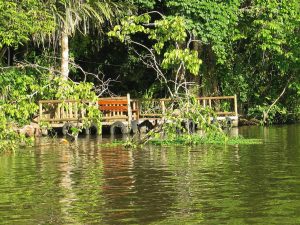
Tortuguero National Park and the Barra Del Colorado Wilderness Area are the most important nesting sites for green turtles (Chelonia mydas) in the Caribbean. Other turtle species that lay their eggs here are the leatherback turtle (Dermochelys coriacea) and the hawksbill turtle (Eretmochelys imbricata). The park’s natural system of lagoons and navigable canals are scenic and home to turtles, manatees (Trichechus manatus), caimans (Caiman cocodrylus) and many freshwater fish.
In the national park you have the opportunity to explore the wet system. You can do this either on foot or in small boats which is the normal means of transport in this region. You have the chance to see monkeys, sloths, caimans, toucans and even the rare magaby.
In the turtle season between July and October you should not miss a guided night hike. Your well-trained guide will explain the various stages of the egg-laying ritual to you. If you are in Tortuguero towards the end of the laying of eggs you can spot small turtles on their first trip to the sea. It really is a miracle of nature to watch. For more information about Tortuguero, see the National Parks section.
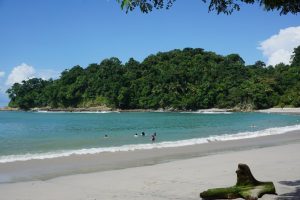
The Central Pacific is well developed due to its proximity to San José. The light sandy beaches and good tourist infrastructure make it easy to relax in this region. Some of the region’s beaches have been awarded the blue flag for their cleanliness and visitor numbers are limited. The Central Pacific Coast offers a variety of recreational opportunities.
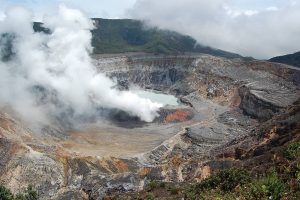
The Central Valley is the hub of Costa Rica. Most of the population lives in this wide valley. In addition to the turbulent, lively capital, there are also some small, enchanted side valleys that are worth a visit. This region is characterized by coffee cultivation on the fertile volcanic soil with mild temperatures in the mountains. Many different national parks and especially the two active volcanoes Poas and Irazu are worth a visit.
When you think of Costa Rica, the first thing that probably comes to mind is a beach vacation. That’s a good thing, because the country has so much to offer that you certainly don’t want to spend the entire holiday on “lazy” skin. Nevertheless, it is good to include some days at the beach in your Costa Rica vacation. Fine sand, palm trees, tropical rainforest right down to the shore and bizarre wooden formations can be found here on the picture-perfect beaches. If you want to relax on the beach, you can do so in Costa Rica on the Pacific as well as in the Caribbean. There are dream beaches on both sides, some of which we would like to introduce below.
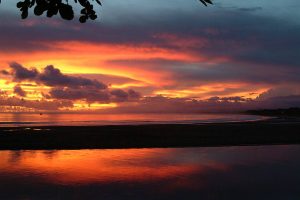
One of the most beautiful beaches in Costa Rica is certainly Playa Conchal, which has white shells and the clear turquoise water is perfect for snorkeling. Many Costa Rica travel brochures contain photos of this fantastically beautiful beach. Playa Conchal is located 1.2 kilometers from Playa Brasilito and 6.7 kilometers from Playa Flamingo in the province of Guanacaste. The 1.5 kilometer long dream beach is shaded by trees, which is particularly pleasant in the dry season when the sun shines between 11 and 12 hours a day. The dry season here lasts from the beginning of December to the end of April. The thermometer then rises to 97 degrees farenheit in the shade. As well as sunbathing and snorkeling, there is an 18-hole golf course on site designed by Robert Trent Jones II. If you want to swing some clubs, you can do so at the Garra de Leon” the lion’s paw”. A day trip to one of the surrounding national parks is also an option.
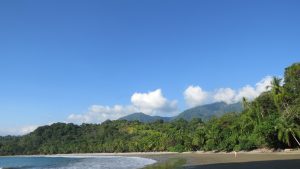 Dominical consists mainly of about a kilometer of dirt road and everything is very easy to walk to. Taxis and buses connect Dominical to Uvita, Quepos and San Isidro de El General.
Dominical consists mainly of about a kilometer of dirt road and everything is very easy to walk to. Taxis and buses connect Dominical to Uvita, Quepos and San Isidro de El General.
On the road from San Isidro de El General to Dominical, about 20 minutes uphill from Dominical are the Nauyaca Falls, which can be reached either on foot or on horseback. About a kilometer north of Dominical there is a large nature reserve called Hacienda Barú. Owner John Ewing tries to preserve the natural diversity of species here through education and settlement. You can see sloths, toucans, butterflies, howler monkeys and more on this enchanted land.
Another attraction is the whale season between the end of July and the end of September. On a boat tour you can watch humpback whales, dolphins and in February, orcas. The whales come from the south to raise their young in the waters off Costa Rica and so you can often see a whale cow with her calf. In addition, the nearby water national park Marino Ballena is a nice destination.
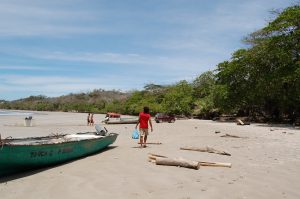
Playa Hermosa is one of the most beautiful beaches in the region with mostly calm waves. In addition to a relaxing day on the beach, diving and sailing opportunities are available. The northern part of Guanacaste is very popular with divers as you can watch the rare whale shark and dolphins. If you desire more action then you can go to the small town of Coco which is more developed for tourism. The national parks of Santa Rosa and Rincón de la Vieja are also worth a day trip.
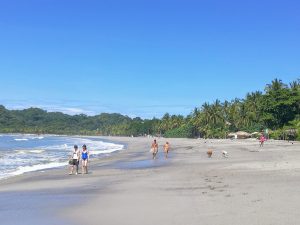 Here you can explore the beach on horseback, snorkel, or catch a dolphin tour. Between July and November, the ridley turtles come to the nearby Ostional Wildlife Sanctuary. In the last quarter of the moon, they come to the beach at night with the first tide to lay their eggs. If you are on site during this time, we recommend that you see it with an expert guide. The guide will educate you on the animals reactions as they are very sensitive to observers. It is really impressive to experience these huge animals!
Here you can explore the beach on horseback, snorkel, or catch a dolphin tour. Between July and November, the ridley turtles come to the nearby Ostional Wildlife Sanctuary. In the last quarter of the moon, they come to the beach at night with the first tide to lay their eggs. If you are on site during this time, we recommend that you see it with an expert guide. The guide will educate you on the animals reactions as they are very sensitive to observers. It is really impressive to experience these huge animals!
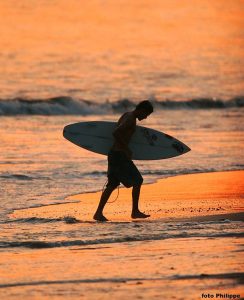
Playa Tamarindo is best known as a surfing area, but there are also quieter sections of the beach where you can swim. The town of Tamarindo is quite busy and offers a wide range of activities from diving tours and day trips to nice restaurants and bars to spend the evening. Playa Grande is opposite Playa Tamarindo. This beach is part of Las Baulas National Marine Park. Turtles come here between October and March from the Pacific to lay eggs. Among them is Costa Rica’s largest turtle, the leatherback. Since the turtles only come to the sea at night, it is advisable to book a tour in the dark. You may only enter the beach with a ranger who has special lamps with a red filter so as not to disturb the animals.
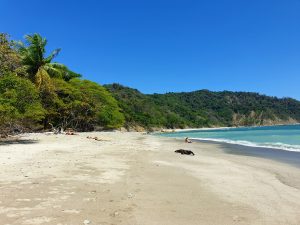
Possible leisure activities here are the discovery of the various protected areas of the region. The Cabo Blanco Nature Reserve is the southernmost protected area for the tropical dry rainforest of Costa Rica. It also includes the island of Cabo Blanco, which is home to many birds. Also worth mentioning is the reserve of Guayabo, Negritos and Pájaros, which consists of 4 different islands to which boat tours are offered. The Curú wildlife sanctuary is a nice spot to spend the afternoon. In addition to a very diverse animal world where you can spend a lot of time observing, the fine sandy beaches are highly recommended.
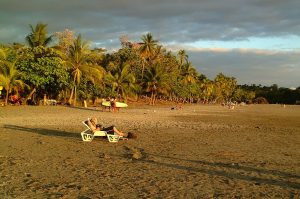
The Pacific coast between Dominical and Palmar Norte is still quite unknown. The beaches are all very wild, long and often flat but there are still strong currents in places.
The beach at Uvita is considered one of the most beautiful on the entire southern Pacific coast. There is a ranger station right on the beach, which gives a good impression of the underwater world with many photos and exhibits. Next to it there is a turtle incubator. Uvita is actually just a collection of small houses, farms, a few cabins, two sodas and a small shop. The real charm of Uvita is discovered when you make your way along the small Estero on the peninsula. There is a small path under the palm trees along the water with bizarre tree roots. On the other side of the new road going into the hills you will find a hidden waterfall with a clear pool full of cool water. A great way to refresh.
Costa Rica’s location between the Atlantic and Pacific Oceans is of particular importance for the country’s volcanism. Costa Rica lies on the plate boundary of the continental Caribbean Plate and the oceanic Cocos Plate which is slowly pushing under the Caribbean Plate or subducting. In this process the oceanic crust of the earth sinks into the magma below the earth and melts. At this point, cracks in the plates create volcanoes on the surface of the earth. More than 100 volcanoes have been formed in Costa Rica in this way. Many of them are no longer active and are now overgrown or almost completely eroded.
Today the active volcanoes can be divided into two complexes. In the northern cordillera “Volcanica de Guanacaste” you will find the volcanoes Arenal, El Hacha, Orosí, Rincón de la Vieja, Miravalles and the Tenorio-Montezuma. The other cordillera in the center of Costa Rica “Volcanica Central” contains the volcanoes Turrialba, Irazú, Barva and Platanar. Today tourists come to Costa Rica not only for the friendly people and the unique flora and fauna but also because of the numerous volcanoes.
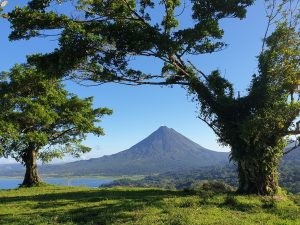 The 1,670 meter high stratovolcano Arenal is located in the province of Alajuela at the national park of the same name and at Lake Arenal. It is the most active volcano in Costa Rica and also the youngest and has an almost perfect conical shape. In 1937, when it was first climbed, no one knew it was a volcano because it was completely overgrown with plants and had not moved for over 400 years. During its last major eruption, on July 29, 1968, it destroyed the two towns of Pueblo Nuevo and Tabacon. Then, until October 2010, the volcano was almost constantly active. At night, tourists could see the red lava flowing down the flanks of the volcano. It has been quiet again for a long time and small plants and trees are starting to engulf the volcano again.
The 1,670 meter high stratovolcano Arenal is located in the province of Alajuela at the national park of the same name and at Lake Arenal. It is the most active volcano in Costa Rica and also the youngest and has an almost perfect conical shape. In 1937, when it was first climbed, no one knew it was a volcano because it was completely overgrown with plants and had not moved for over 400 years. During its last major eruption, on July 29, 1968, it destroyed the two towns of Pueblo Nuevo and Tabacon. Then, until October 2010, the volcano was almost constantly active. At night, tourists could see the red lava flowing down the flanks of the volcano. It has been quiet again for a long time and small plants and trees are starting to engulf the volcano again.
Lush rainforest grows around the volcano and there are numerous rivers, waterfalls and a great flora and fauna. Some springs are heated by the heat of the volcano and are popular tourist destinations. The small town of La Fortuna offers great starting points to discover the different areas around the volcano.
Just a few kilometers from the capital, San José , the dormant Barva Volcano towers at 2,069 meters. With its three widely separated peaks, it not only stands out from other volcanoes, but also owes them the name “Las Tres Marias”. It is said that it was created around 322,000 years ago in a massive eruption. Scientists estimate its last eruption to be around 6,050 BC.
To visit the volcano, simply cross the easily accessible national park ”Braulio Carillo“. In the midst of dense rainforest with lush vegetation the trail goes uphill very close to one of the volcanic craters. On the way you are bound to meet one or two monkeys or an agouti. Rarer inhabitants of the rainforest are the bird of the gods quetzal and the king vulture. Even if you don’t see the two birds, once you get to the top, the unique view is worth the effort. You can see the surrounding valleys or one of the three crater lakes. The 500 meter wide Danta crater lake testifies to the enormous size of the volcano.
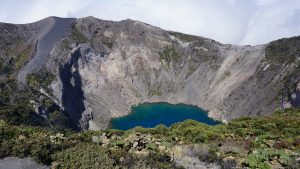 The 3,432 meter high active Irazú Volcano is the highest volcano in Costa Rica and is located in the center of the Irazú National Park . It is considered the most dangerous and unpredictable volcano in the country and translated from the Indian language means “rumbling mountain”. In good weather you can see both the Atlantic and the Pacific Ocean from up there. Since 1994 there has been a series of minor to major eruptions. The last major ones took place between 1962 and 1965 and blew out ash and rocks that were carried with the wind to San José. Then the chimney blocked up until it broke open again in 1994 with smaller eruptions.
The 3,432 meter high active Irazú Volcano is the highest volcano in Costa Rica and is located in the center of the Irazú National Park . It is considered the most dangerous and unpredictable volcano in the country and translated from the Indian language means “rumbling mountain”. In good weather you can see both the Atlantic and the Pacific Ocean from up there. Since 1994 there has been a series of minor to major eruptions. The last major ones took place between 1962 and 1965 and blew out ash and rocks that were carried with the wind to San José. Then the chimney blocked up until it broke open again in 1994 with smaller eruptions.
Similar to the Poás volcano, Irazú also has a crater lake, which colors from green to yellow and red depending on the minerals in the crater walls and the algae in the water. There is little vegetation around the crater. The treeline should actually reach almost to the summit here, but the area is more like a lunar landscape. Nevertheless, a few unique plants and flowers thrive here. The same is true of the animal world. Few climb this wasteland in search of food. Species such as wild rabbits, armadillos and coyotes have been spotted here so far, and a few birds fly around as well. A little further below the summit begins a dense cloud forest which has a large number of flora and fauna. Farmers also cultivate potatoes, cabbage and other vegetables on the fertile southern flank.
Not far from the Tenorio volcano is the Stratovolcano Miravalles. Stratovolcanoes, also known as a composite volcanoes, are conical volcanoes built up by many layers (strata) of hardened lava and tephra. This is also how the Miravalles was born. It is 2,028 meters high and was formed around 0.6 to 1.5 million years ago. Larger eruptions are not recorded, only a smaller gas explosion in 1946. Around the volcano bubbling water comes to the surface and you can admire fumaroles and geysers.
Tapirs , pumas and other animals living in the dense tropical vegetation have been spotted near the volcano. There is also a huge geothermal reservoir underground which is why Costa Rica’s first geothermal field is located here. Here hot water (heated by the volcano) is turned into electricity. The plant has an output of 166 megawatts and thus supplied almost 13 percent of the country with electricity in the year 2009.
The Orosí is located in the Guanacaste National Park on the border with Nicaragua. Together with the volcanoes Orosilito, Pedregal and Cacao it forms a complex of four extinct stratovolcanoes. The highest of them is the Cacao volcano, with a height of 1,659 meters.
A rich flora and fauna can be found around the volcanoes which is why the research station Maritza Biological Station was built at the foot of the mountains in 1989. This station carries out studies on tropical ecosystems. The complex has long been extinct and no eruptions have ever been recorded.

The complex volcano is 2,708 meters high and is located about 35 kilometers north of Alajuela in Poás National Park. It is often obscured by clouds, but every now and then they reveal the view of the beautiful turquoise blue crater lake which is almost 300 meters deep. The lake is an acid lake with a pH below 1 making it one of the most acidic crater lakes in the world and one of the largest at 1.5 kilometers in diameter. Here it bubbles and steams like in a cauldron. However, the toxic gasses prevent any kind of downwind vegetation, which is why it is almost extinct around the crater.
A beautiful hiking trail leads from the main crater to the second extinct crater lake Botos, which is filled with rainwater. Not many mammals live here, but hummingbirds, tanagers and other birds are often seen. Coffee plantations are cultivated on the slopes of the Poás. The last eruption occurred on February 25, 2014 ejecting rock and water more than 300m high. Since the volcano can erupt constantly the highest safety precautions apply here so that tourists can be evacuated as quickly as possible at the slightest sign.
![]()
The 1,916 meter high volcano Rincón de la Vieja is located in the 14,000 hectare national park of the same name, 25 kilometers from Liberia. This volcano also has an acid lake with a diameter of 250 meters. Temperatures of up to 90°C have been measured here. In 1998, the lake spilled over in an eruption, causing a huge mudslide that destroyed bridges, plantations and roads. The last major eruption was on September 22, 2011 and it still shows occasional activity.
In the national park, in the “Las Pailas” sector, there are hot springs, bubbling mud pools and fumaroles that emit stinking sulfur vapor. One of the last primary dry forests in Costa Rica grows on the flanks of the volcano. The tree line is around 1,600 meters and mostly moss grows on the slopes of the volcano. Orchids and other beautiful flowers grow here due to the high humidity. Depending on the altitude, agoutis, coatis, iguanas and numerous bird species can be found here.
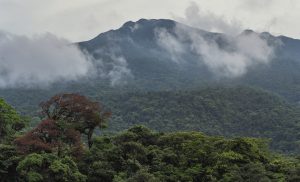 Tenorio Volcano is located in northern Costa Rica in Tenorio National Park about 1.5 hours from La Fortuna. It is 1916 meters high and is located in a beautiful landscape with small geysers, thermal springs, rainforests and waterfalls. The Rio Celeste in particular is a magnet for tourists. Translated, it means “light blue river” and lives up to its name, especially when the sun is shining. Minerals and reflection create a unique blue color. Down in the drier areas you can sometimes even find savannah-like areas and dry forest areas.
Tenorio Volcano is located in northern Costa Rica in Tenorio National Park about 1.5 hours from La Fortuna. It is 1916 meters high and is located in a beautiful landscape with small geysers, thermal springs, rainforests and waterfalls. The Rio Celeste in particular is a magnet for tourists. Translated, it means “light blue river” and lives up to its name, especially when the sun is shining. Minerals and reflection create a unique blue color. Down in the drier areas you can sometimes even find savannah-like areas and dry forest areas.
However, the further up you go, the more the mixed forest is replaced by a primary forest, in which numerous animals and various plants find a home. The Tenorio has 2 craters on a total of four peaks, but eruptions are not known or recorded. Only one legend speaks of an eruption in 1816, the fully overgrown volcano, however, speaks against it. On a good day, you can see Lake Arenal, Lake Nicaragua and the lowlands of San Carlos from the summit.
At 3,325 meters, Turrialba is the second highest volcano in Costa Rica and is located just a few kilometers from the Irazú volcano and the country’s capital of San José. It has four craters, the oldest of which is already extinct. Several eruptions occurred in the 19th century, the last major one in 1996 when a pyroclastic flow rushed down the slopes. After that, the volcano was quiet again for a long time until it showed activity again in 2006. It was only in May 2015 that Turrialba erupted more violently and spat out an almost 1,000 meter high ash cloud, which led to the temporary closure of the airport in San José (for 1 day). Experts spoke of this as the worst outbreak in 20 years.
In the Turrialba Park there are various ecosystems from tropical humid rainforest to very humid and premontane rainforests in the upper regions. Orchids, ferns and bromeliads grow on the trees here. Numerous bird species and up to 11 mammal species can also be seen here
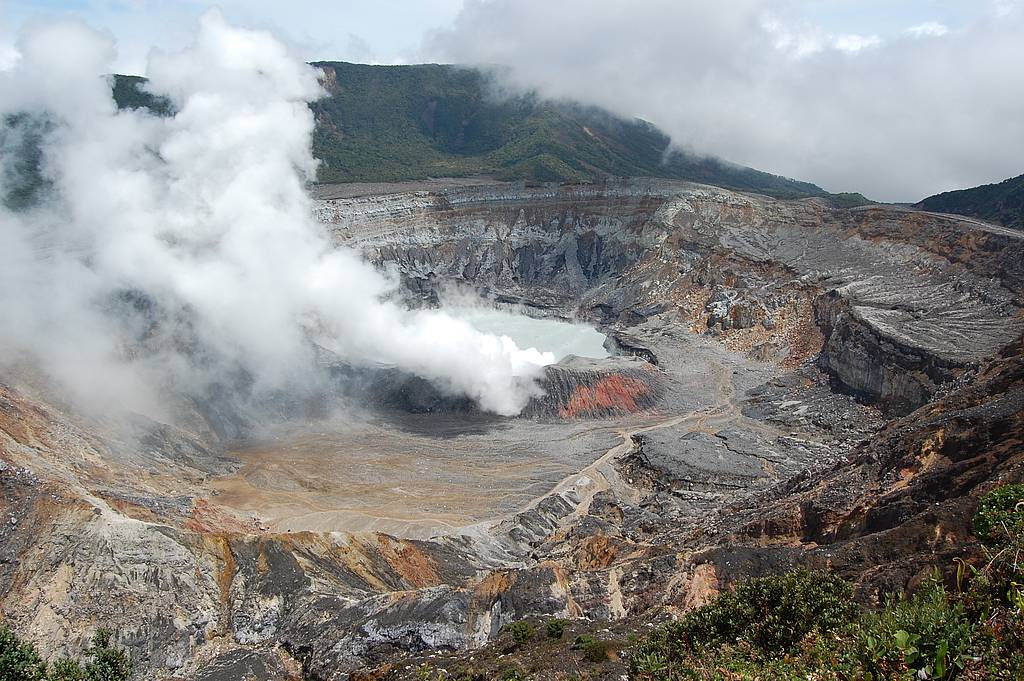
Don’t know when to visit? Find out more about the best times to travel to Costa Rica based on weather or flora and fauna.
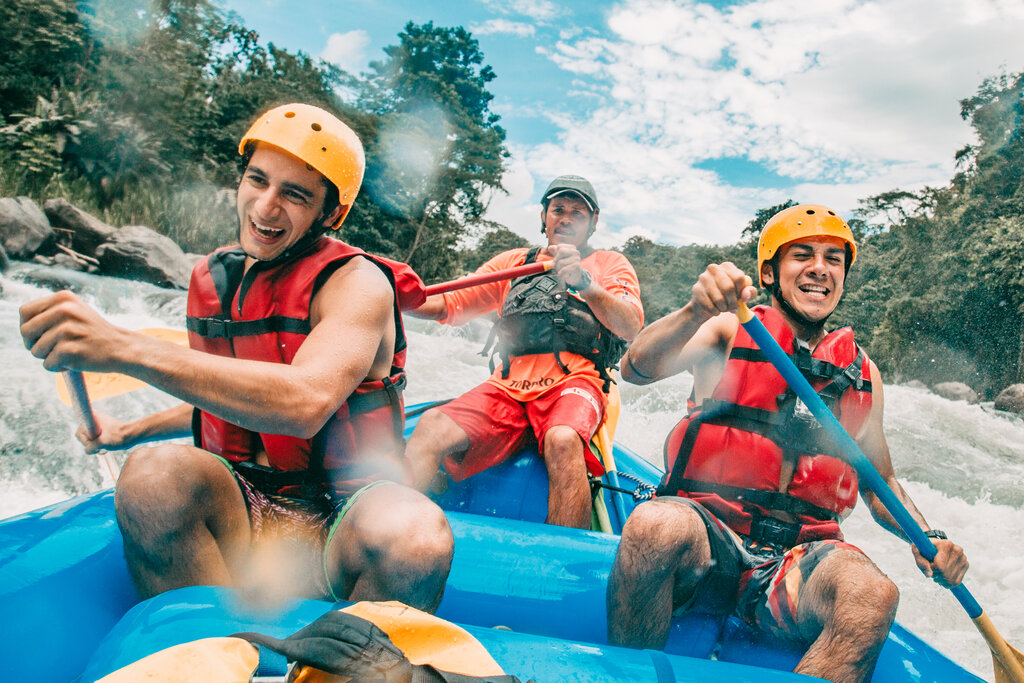
The possibilities are endless. Those with a head for heights can enjoy a canopy tour while ocean lovers ride waves surfing.

Many questions such as “What do I need to enter the country” arise during the travel planning. We answer these questions for you.
We are your contacts for a successful stay in Costa Rica and look forward to your inquiries: info@costaricainsider.com